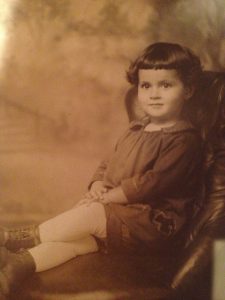She had one leg shorter than the other. Not in such a glaringly obvious way that one would immediately notice, but you could tell if you studied her walk or she pointed it out to you, like she did to me when I was little.
I couldn’t fully understand the story as a child, but my mother had contracted Polio when she was around three years old, and almost died. I remember that part because she had two names. Mildred was the name she was given at birth, and Goldie was the name she was re-named after she had recovered, as is customary in the case of near death experiences in the Jewish religion.
By the time I was born, the Polio vaccine had been developed and was administered widely to children in the United States. Polio was nearly eradicated in this country by then, and so the story of my mother’s near death from Polio became to me a long-ago folk tale from her childhood.
Sadly, that has not been the case for the rest of the world. Sure the numbers have dropped 99% since 1988 when there were 350,000 known cases around the world, to the 218 reported cases in 2012. Still, the fact is, that as long as Polio remains in even one child, children the world over are at risk of contracting the disease. The victims of the highly infectious Poliomyelitis virus that attacks the nervous system are usually children younger than five years old.
This past week India announced reaching the milestone of two years without a reported case of Polio. In turn, India was removed from the list of Polio-endemic countries by the World Health Organization. This leaves the three countries of Pakistan, Afghanistan, and Nigeria on that list. This is a major accomplishment for the country that was once the epicenter of the disease, and predicted to be the last country to eradicate Polio from its population.
India did not do it alone; the success of this global effort was due to the combined support of the Indian government, the World Health Organization, Unicef, the Gates Foundation, and Rotary International. There is still work to be done, and still cultural biases in some areas against vaccines to be overcome, but India’s success shows us that it is possible. In the meantime as long as the virus still exists in any country, it can rapidly spread and devastate new populations. A simple vaccine can prevent it from doing so.
The United Nations Foundation and the Shot@Life campaign has just invited me to attend the upcoming Shot@Life Champion Summit in Washington, DC later this month. Now that I am a mother, I can more empathetically understand what my grandmother must have gone through when my mother was sick as a child. I can now comprehend how lucky she was to fully recover, albeit one leg shorter than the other, and to live into her seventies. Now that I am a mother myself I also can not bear to imagine any mother losing a child to an easily preventable disease.
Shot@Life educates, connects and empowers Americans to champion vaccines as one of the most cost-effective ways to save the lives of children in developing countries. A national call to action for this global cause, the campaign rallies the American public, members of Congress, and civil society partners around the fact that together, we can save a child’s life every 20 seconds by expanding access to vaccines. –www.shotatlife.org
At World Moms Blog we are bonded across nations, cultures and seas by our shared journey of motherhood, and the universal fierce love we all feel for our children. At the Shot@Life Summit I will join other Champions, who will be mentored by World Moms Blog founder, Jennifer Burden, and Social Good Editor, Nicole Melancon, among others. I will be taught alongside those selected to become Shot@Life Champions from across the United States, including two other World Moms Blog writers, Nicole Organ, and Lauren, to learn the skills needed to become leaders in our movement to make sure that every child gets a shot at a healthy life.
I am thrilled to become a Shot@Life Champion and I hope that through the work I do, and the collective effort of all of those fighting to eradicate Polio from this world, we can make Polio an old haunted folk-tale from the past to us all.
Have you known anyone effected by Polio? Will you join us to help wipe it out and give all children around the world a Shot@Life?
If you would like to become an advocate for Shot@Life, you can learn more here.
This is an original post for World Moms Blog by Elizabeth Atalay, mother of four.







Great post,Elizabeth!
I live in Cape Town, South Africa, but let me know if there’s anything I can do to help. This is a GREAT cause, and I pray that we WILL eradicate Polio completely in OUR lifetime. What a legacy that would be … being the generation to accomplish this! 🙂
Simona, it is exciting to know that we are so close to putting an end to this disease! Thanks for your help!
Thanks for writing about this Elizabeth!
My mom had polio when she was a child also. She now uses mainly a wheelchair to get around (she used to be able to use crutches when I was a child) and it’s getting to be more and more of a challenge for her. When she does talk about the years that she spent in the hospital it’s really painful to hear about.
I will be so excited when this disease is finally gone.
Wow, Melissa thanks for sharing, I’m sorry your mom was so impacted, but I guess both our mothers were fortunate to have survived. Isn’t it amazing that just the generation before us was afflicted with it, and we are fortunate enough to bring our kids up in a place where we have eliminated that risk to them.Hopefully that will be the case world over in the near future!
Thank you for sharing your story and for your efforts on behalf of Shot@life. I don’t have experience with this disease, but I can imagine the pain of watching your child endure it. Hopefully it will someday be eradicated.
Me too Tara! Thanks for your comment.
Hi Elizabeth,
I bet your grandmother and mother would be so proud of you for championing Shot@Life for kids across the world to help put an end to polio. What an incredible post! You’re going to make a great champ!
So excited to see you next month in DC for the Summit!!
Jen 🙂
Thank you Jen, you are an amazing inspiration and mentor for more than just the shot@life campaign! I am so grateful for all of your guidance & friendship.
You are too kind. I think you’re amazing!!!
Jen 🙂
What a moving post Elizabeth! My mother is quite young and was already vaccinated as a child, but being of European birth, I always remember the permanent mark that she has on her arm from her vaccination. Apparently, the booster in some countries is given in such a way so that you have a circle on your upper arm for your entire life…or so she said :-). Either way, wouldn’t it be wonderful if we could completely irradicate the disease (like we did smallpox) and then we wouldn’t need to give the world’s children the vaccine at all! What a wonderful (and seemingly attainable) goal!
Have a great trip to DC!
I forgot about those scars from the vaccine, actually I have one too on the back of my upper arm! I guess it has changed since then since the new vaccines don’t leave that mark…now I have to go look that up and see when/how it changed.
Thank you so much for sharing your mother’s story– what a powerful reminder of the fact that although the cases we are advocating for seem so far away, that was not always the case. Looking forward to meeting you in person at the summit!
Elena — I’m excited to see you there, too! It’s going to be an awesome group of Champions for Shot@Life!
Hi there, a friend of my mums caught polio at age 3. Her left leg was affected by polio and she had a severe limp as a result.She did not,however, need a stick or a caliper but needed to have her left shoe built-up by about 1 inch. She was a very attractive lady but she did not have any menfriends. I think some lame ladies decide that they will not be attractive to men and therefore do not bother with them. She lived a full life and drove an adapted car.